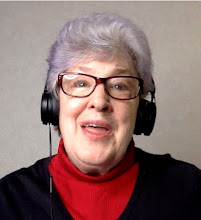- show an extensive repertoire, including lieder and “art songs” as well as arias and excerpts from operas, oratorios, or cantatas, contemporary as well as pieces from previous centuries.
- be able to sing in a variety of languages - Italian, of course, German, French, and so on - and be judged on pronunciation.
- have a range of at least two octaves.
- know how to select pieces that are most appropriate for one's own vocal type (coloratura, contralto, baritone, etc.) and range.
- use the body appropriately to control breath, including vibrato, and pitch.
- project vocally according to the piece, being able to go from pianissimo to fortissimo, and the acoustics of the performance hall.
Naturally, “showmanship” would be taken into consideration. Whenever I sing for the Sapporo Academy Chorus in-house rehearsals, I always wear clothing that fits the piece - for example, a bright red dress with big, black polka dots for a Gershwin medley; a loose-sleeved blouse, long vest, knee pants, and tights for a Cherubino aria from Mozart's “Marriage of Figaro.”
Interpretation of the piece is, of course, essential. Does the singer use the right volume, degree of vibrato or nasality, “color” or degree of warmth, and other factors that match the piece?
In an interesting article entitled “The Voice that Charms,” Wah Keung Chan states, “A good singing competition is every bit as exciting as a figure skating meet; both competitions are judged on technical and artistic merit. 'Voice, musicality and presence are the criteria,' said André Bourbeau, president of the jury [of the First Jeunesses Musicales Montreal International Competition in Voice]. Technically, the characteristics of a great voice are timbre (colour and ability to project in a large hall), legato, flexibility (coloratura), dynamic range, and diction. The hallmarks of a great singer are the ability to make a good voice communicate the message and emotion carried by the text and the music.” (La Scena Musicale - Vol. 7, No. 9, June 1, 2002; accessed May 4, 2008)
Diana Yampolsky divides the performance into physical sound and emotional style, saying, states, “Physical sound is what is achieved by proper utilization of the technical aspects of singing, i.e. breathing (support), structure, placement and projection. Emotional style is essentially how the singer relates to the song and anticipates and complements the style of music....” (See another interesting analogy to a skating performance in “The Technical Elements of Vocal Style”, Indie-Music.com, January 13, 2002; accessed May 4, 2008.)
In the auditions, sight reading and a pitch matching test might be included, much like the technical aspect of a skating competition. I've had to sightread for most of serious auditions, and I once had to sing an atonal scale backwards as well as be able to sing various intervals on sight (3rd, 4th, 5th, and so on, in both major and minor keys).
As you can see, I got so intrigued by this topic that I did some Internet searches. As I did so, I was disturbed by the fact that ageism is rampant in classical music singing competitions (as in American Idol), often limiting entry to contestants under 35. This is particularly dismaying to me since I didn't really “find” my true voice until I was in my 50s, and had a successful audition for the Sapporo Symphony Chorus when I was over 60. I was please to discover that Contralto Karen Mercedes has put together a list of competitions with no upper age restrictions. Time to start working on my repertoire!




